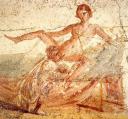 You might not know this given the centuries governments and cultural institutions have spent covering up the material remains of Roman licentiousness, but explicit sex and nudity were very much a fixture of everyday public life in ancient Rome.
You might not know this given the centuries governments and cultural institutions have spent covering up the material remains of Roman licentiousness, but explicit sex and nudity were very much a fixture of everyday public life in ancient Rome.
Deemed too shocking for women, children and the lower classes, artefacts that were later labelled pornographic were kept behind locked, and even bricked-up, doors in what became known as the Secret Museum established in 1819 in the National Archaeological Museum in Naples.
There was also a series of secret rooms in London’s British Museum.
On occasion, admittance to the Naples secret chamber was permitted to responsible gentlemen of good moral character, including young males of the wealthy elite enjoying a gap year by undertaking the European Grand Tour to complete their “education”.
These same gentlemen could also gain access to a series of peep shows kept under lock and key at Pompeii where specially built steel cabinets kept various frescoes and murals from general view.
The Secret Museum was opened only briefly during the social revolution of the 1960s. It was closed again until 2000. Since 2005 the collection has been housed in a special room. Entry is gained by a separate ticket.
Interesting how porn was a privilege of class and male gender. These sexual images were seen as genuinely dangerous to public morality. In order to see them, you had to prove yourself above it all in some way, a scholar and a gentleman, who might examine them in dirty, dirty secret, but never get the hint of a boner or even a giggle, heaven forfend.
 This is a glimpse into how the modern notion of pornography was born: explicit sex removed from its social context and ghettoized in the name of protecting those who cannot be trusted to cope with (read: repress) arousal. The word “pornography” was actually coined as a description of classical erotica in the 1850’s, derived from the Greek words for prostitute (porne) and to write (graphein). It wasn’t until several decades later that it began to be used to describe prurient art in general.
This is a glimpse into how the modern notion of pornography was born: explicit sex removed from its social context and ghettoized in the name of protecting those who cannot be trusted to cope with (read: repress) arousal. The word “pornography” was actually coined as a description of classical erotica in the 1850’s, derived from the Greek words for prostitute (porne) and to write (graphein). It wasn’t until several decades later that it began to be used to describe prurient art in general.
For a wonderfully entertaining running commentary through the Secret Museum of the National Museum of Archaeology in Naples, listen to this BBC radio story by Lynda Nead. The analysis of the significance of the Secret Museum in the dawn of pornography in the 19th century is fascinating. Besides, there’s nothing like hearing about creamy-fleshed girls straddling giant phalluses as described by British professors.
Great article! And a good point about how the moral protectionist angle had the curious side effect of reserving the porn for the enjoyment of the gatekeepers.
I wonder what stories could have been told by the wives, or more likely the prostitutes, with whom those moral guardians came into intimate contact. “Will you be Jupiter again today, my glorious white bull, and I Europa in the pasture?” 😀
😆 “Priapus has got nothing on you, my Lord.”
When I visited the Naples museum back in 2002 or so, my mother and I leapt at the chance to see the Secret Room because of course we heard the sordid stories about the horrors kept within the Room.
My first thought upon seeing the objects and the frescos was “Awww how cute are they?!”
It was an enjoyable trip into the Romans’ sex lives.
Oo, lucky! I’ve never had the chance to see the Secret Museum. One of the things Lynda Nead discusses in the BBC story is that putting all that stuff together in one “sex room” sort of kinkifies it all, or pornographizes it.
Apparently there’s a cabinet of phalluses that used to hang like windchimes in doorways the way people use horseshoes now. Seeing them all together in one display strips them of their good luck, town-wide context and makes it looks like the dildo section of a sex shop.